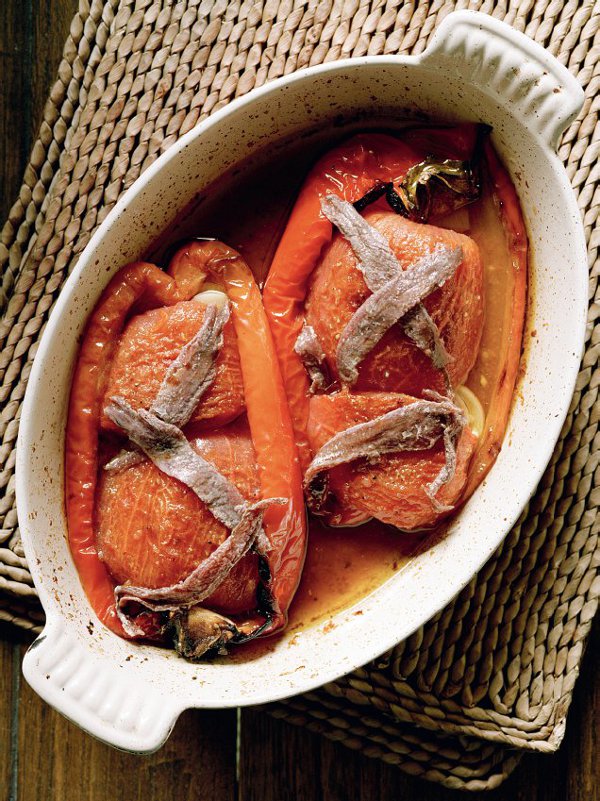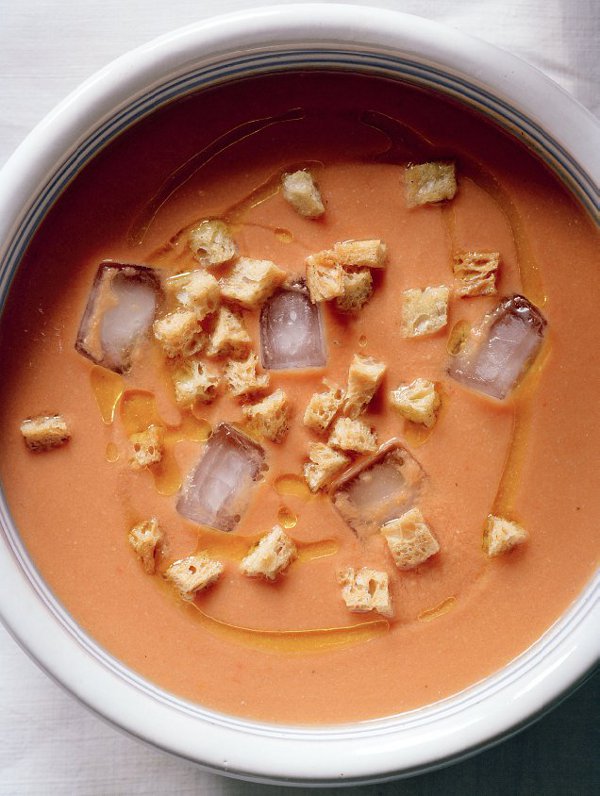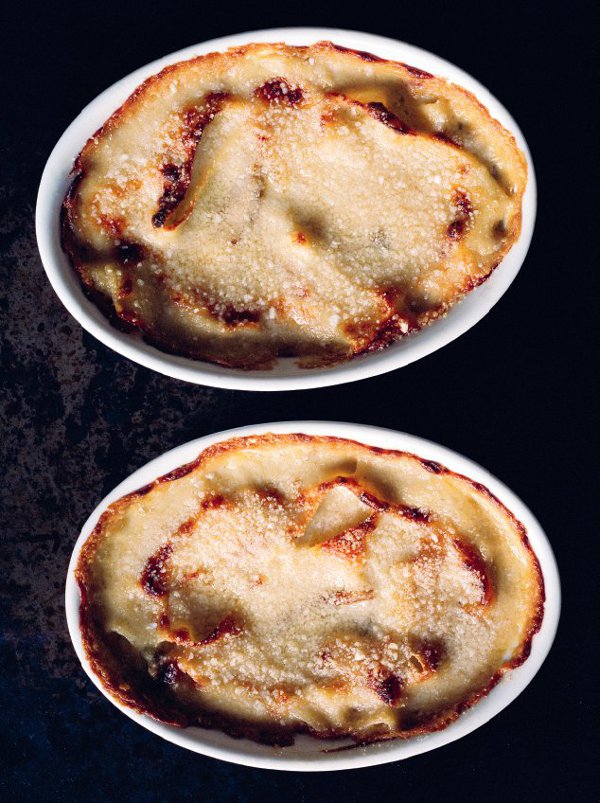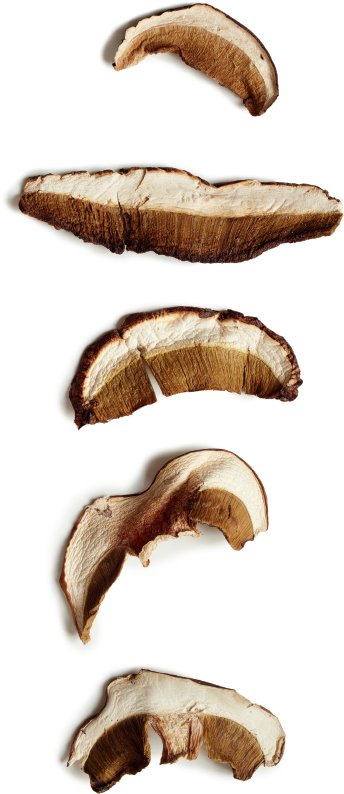Good Cook (8 page)
Authors: Simon Hopkinson

serves 4
4½ lb broad beans, podded
7 oz fresh ricotta
4½–5 oz firm smoked cod’s roe, peeled of its membrane
fine and fruity olive oil
salt and freshly ground black pepper
Truthfully, this is nothing more than an assembly of immaculate ingredients. However, it is a harmonious and sunny sort of thing, with its green slippery beans, splashes of bright white cheese and golden-orange roe, all glistening with fruity olive oil. If you can get it, there lurks some astonishingly delicious sheep’s milk ricotta in occasional fine cheese shops. Ask your favorite monger for this rare, fermented curd.
Before you start, have ready a bowl of cold water with several ice cubes in it.
Cook the broad beans in boiling salted water for about a minute. Drain and immediately plunge them into the bowl of ice-cold water. Peel the pale green skins off the beans and put on a shallow serving dish. Randomly place pieces of ricotta and thin slivers of the roe over the beans, then liberally douse with olive oil. Season with salt and pepper.
Eat with bread.
serves 4
12 slices of Parma ham
for the dressing
good pinch of sea salt
1 small clove of garlic, crushed to a paste with the above
2 tbsp red wine vinegar
1 small shallot, very finely chopped
freshly ground black pepper
5–6 tbsp olive oil
for the greens, all well washed and dried
2 large handfuls of small spinach leaves
2 large handfuls of watercress
2 large handfuls of pea shoots
1 large handful of arugula
several mint leaves, roughly chopped
I ought to say here that when it comes to the most beautiful Parma ham, I cannot think of anything more than just that; quite unadorned and fiddled about with, laid upon a pristine white plate in delicately rumpled sheets. However, sometimes, just sometimes, it is interesting to see how a judicious and tasteful addition can work with an ingredient that is, how shall we say, happy in itself.
We used to serve a version of this at Bibendum, some years ago now. I think it is rather nice. For one thing, although it is a composed dish, both components shine without outdoing the other: the greens quietly warm the ham, while their wrapping offers a meaty note of great subtlety and savor. A swish dish.
Make the dressing by whisking together the first 5 ingredients, then slowly incorporate the olive oil as for making a vinaigrette dressing—which is, after all, what it is. Pour into a wok or large frying pan and begin to warm it over a low heat. Tip in all the greens and toss and turn using a couple of salad servers, say, until wilted but not limp past recovery. Pile into a colander set over a large bowl,
reserving the precious liquid beneath. Allow the greens to cool to a warm, room temperature. Once well drained, pour the “precious liquid” into a small, stainless steel pan and reduce, over a moderate heat, until well flavored and with the look of a murky-looking dressing; the greens will have imparted their stain but also, more importantly, their flavor to the original, simple vinaigrette. Add this reduced liquid back to the drained greens.
Now, put a tablespoon of the greens on a slice of ham, deftly roll it up and place on a large flat serving dish. Repeat this process with the remaining 11 slices of ham, so arranging them that they will please the eye. Spoon the reduced dressing over these diminutive bundles and serve forthwith.
I have been known to fling an occasional dusting of freshly grated Parmesan over these, from time to time. Feel free, but don’t go mad.
serves 4
4 red peppers
8–12 ripe plum tomatoes
4 cloves of garlic, peeled
a little salt
freshly ground black pepper
5–6 tbsp good olive oil
8 large Spanish tinned anchovies, cut in half lengthways, or 16 whole small ones
In the early 1990s, pictures of this dish adorned the tiled walls alongside the escalators on the Bakerloo line. They were extracted from an excellent, bestselling cookbook of the time. However, it was a bit surreal to see a plate of food, originally from a recipe in Elizabeth David’s
Italian Food
, now illustrated on London’s ancient tube system. Then again, it was good to see such a pretty picture at rush hour. And, furthermore, it may have inspired the occasional commuter to rush home and cook such a thing. Without beating about the bush, it is the most delicious event ever to happen to a pepper.
Preheat the oven to 375°F. Cut the red peppers in half, lengthways, slicing right through the stalk (leave it attached, simply for the look of the finished dish). Remove the seeds and cut out the pithy parts. Pour boiling water over the plum tomatoes, leave for 10 seconds, peel off their skins and then cut out the core. Place the halved peppers into an ovenproof dish (one that will be nice enough to present later, at table). Slice the garlic into slivers, distribute over the inside of the peppers and then fit the tomatoes inside, pushing them gently into the space. Add only a little salt, but a normal grinding of pepper. Spoon over the olive oil and then slide the dish into the oven. Bake for about 45 minutes to 1 hour, turning the heat down a little if you notice any excessive scorching of the peppers.
Once they are nicely softened, slightly collapsed, scorched in places and smelling quite wonderful (they always do), remove from the oven. Criss-cross each pepper half with an anchovy, baste with the copious, oily juices and allow to cool to room temperature.


serves 6
3 oz sherry vinegar
10 oz water
1 cucumber, peeled and chopped
1 red pepper, seeded and chopped
1 green pepper, seeded and chopped
1¼ lb very ripe tomatoes, skinned and chopped
5 oz passata (or tomato purée)
3 cloves of garlic, peeled and crushed
1 onion, chopped
1 scant tsp Tabasco
small handful of mint leaves
salt and freshly ground black pepper
aprox 2 cups crushed ice
9 oz extra virgin olive oil
to serve
tiny croutons, made from a few slices of white bread, cubed, and then fried in olive oil until crisp
Hot Spanish sunshine. Chilled glass of fino. Lunch. 2:30pm. Post swim. T-shirt and damp shorts. Espadrilles. Panama hat. Unfed cat at sandy feet. Beachside table. More hot Spanish sunshine. Cold soup. Gazpacho.
Note: there are those who think that a gazpacho should be chunky or garnished with more of the already included ingredients as dice. I don’t. I love the smoothness of this recipe and find that bits of extra vegetables simply get in the way. However, I wouldn’t miss out on the croutons for anything. I have said many times before that croutons in any smooth soup—hot or cold—do lovely things to the mouth, when supping.
Purée all the soup ingredients together until smooth, apart from about a third of the olive oil. Pass through an ordinary, round sieve (not too fine) while pressing down well on the vegetables to extract as much flavor as possible. Whisk in the rest of the olive oil and pour into chilled soup bowls; although the soup is already chilled due to the crushed ice, drop an extra ice cube into each serving. Hand around croutons at table.
serves 2, heartily
18 oz milk
¾ oz dried porcini
3 tbsp butter
2 tbsp all-purpose flour
salt and freshly ground black pepper
3½ oz pappardelle
2 oz thinly sliced pancetta, cut into ¾-in pieces
4–5 tbsp freshly grated Parmesan
The following, utterly delicious recipe has been inspired by two of my most loved restaurants. The first one, that venerable Venetian institution, Harry’s Bar, makes a gratin of fine ribbon pasta (tagliolini), which is baked with slivers of smoked ham in a rich béchamel sauce, then finished with a fine crust of Parmesan.
The other place is the Walnut Tree Inn, near Abergavenny, when Franco Taruschio used to run it as chef-proprietor together with his wife, Ann, for over three decades. The dish in question here was the legendary Vincisgrassi: fresh porcini (often picked locally) and Parma ham, layered between sheets of lasagne and thick smears of béchamel, also baked with Parmesan. Franco’s extra joy was to shave a generous topping of white truffle on the finished dish, just before sending to table. The smell, oh, the smell!—as it was placed before this greedy boy.
Preheat the oven to 400°F.
Just warm the milk in a saucepan and then soak the porcini in it for about 10 minutes. Drain the milk through a sieve suspended over a bowl, pressing lightly on the porcini with the back of a ladle to extract all the milk. Put the mushrooms to one side. Rinse out the pan and wipe it clean, then use it to melt the butter. Tip in the flour, stir it around and cook quietly for a few minutes without coloring the roux. Pour in the porcini-flavored milk all in one go and whisk together vigorously
until smooth. Cook over a very low heat, stirring now with a wooden spoon, for about 10 minutes, until the sauce has thickened—and it should not be too thick. Season lightly with salt and generously with pepper. Put on a lid and set aside.
Bring a large pan of boiling, salted water to a rolling boil. Plunge in the pasta, bring back to the boil and cook until it is a little underdone (taste some); it will cook more when it is baked. Drain in a colander, tip into a roomy bowl and deftly mix with the sauce, while also introducing the porcini and pieces of pancetta. Once well combined, tip into a lightly buttered dish and lightly tap down. Strew about 2 tablespoons of Parmesan over the surface and bake in the oven for 30–40 minutes, or until it is bubbling around the edges and the top is gorgeously crusted a light brown. Take to table in its dish and spoon out on to hot plates, the remaining cheese handed separately to sprinkle over each serving.


